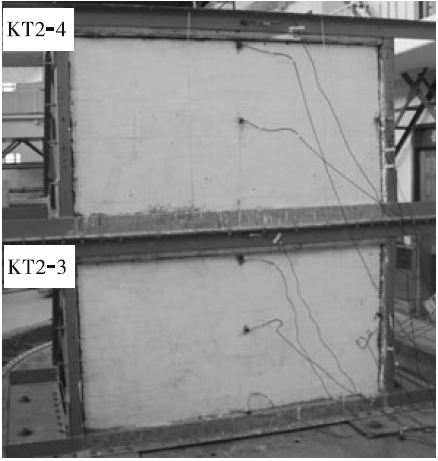In order to achieve an optimal antiseismic behavior, or even stability, two methods of connection are investigated. The shaking table tests, with 1:3 scale walls of two-storey model subjected to horizontal earthquake loads, were carried out to investigate the out-of-plane behaviors with different connections between walls and beams. The test results show that the connection methods employed bet
In order to achieve an optimal antiseismic behavior, or even stability, two methods of connection are investigated. The shaking table tests, with 1:3 scale walls of two-storey model subjected to horizontal earthquake loads, were carried out to investigate the out-of-plane behaviors with different connections between walls and beams. The test results show that the connection methods employed between walls and beams have a significant effect on the out-of-plane stability of infill walls. The walls bound by bars with the beams perform better than those with inclined bricks without gaps.
PROBLEM
It is shown that an arch is formed in masonry wall under earthquake motions when the wall and frame are connected effectively, by which some earthquake energy can be released and therefore the out-of-plane stability of wall can be enhanced. The inappropriate connection method between frame and wall is the major factor of its instability. In addition, the height-to-thickness ratio and the height of building cannot be neglected.
SCOPE
This paper focuses on the out-of-plane behaviors of infill masonry wall subjected to earthquake loading, in which the connection methods between infill walls and frames are discussed.
DESIGN AND CONSTRUCTION OF THE TEST SPECIMENS:
A 1:3 scale model structure was selected. The test was carried out on the shaking table of Dalian University of Technology. The two-storey model framework including a concrete-steel frame and four infill walls.
The concrete blocks used for the test, with a dimension of 130 mm x 63.3 mm x 63.3 mm, were made of common blocks by 1:3 scale. The compressive strength of the concrete blocks is 5.4 N/mm2. Concrete and mortar were chosen in the test. Two kinds of connection styles were discussed: one was between walls and beams filled with inclined bricks, which was applied to walls of KT2-1 and KT2-2; the other was done by binding the walls and beams with the bars of 2phi 2@266 with 3 mm gaps on the walls of KT2-3 and KT2-4. The gaps could be filled with polyurethane vesicant in the buildings. The rigid connection between wall and frame could improve the structure’s stiffness effectively, but it could also increase the horizontal earthquake motions and confine the deformation of the structure, which reduces the energy dissipation ability.
Specimens:

Test setup:

Reinforcement design:

CONCLUSIONS
(1) The overall performance of infill masonry walls shows that walls bound by bars with beams perform better than those with inclined bricks without gaps. It also indicates that the binding bars contribute to the out-of-plane capacity of walls significantly.
(2) Waves affect the response of walls, but they do not lead to significant influence under the same level of earthquake motion.
(3) Height is another factor that influences the out-of-plane stability of infill walls.
(4) The displacement responses fulfill the requirement of GB50011-2001.
(5) The out-of-plane safety of infill masonry walls under seismic actions can be guaranteed if some kinds of connections are applied properly between walls and frames.
RECOMMENDATIONS FOR FUTURE RESEARCH
None were specified.











